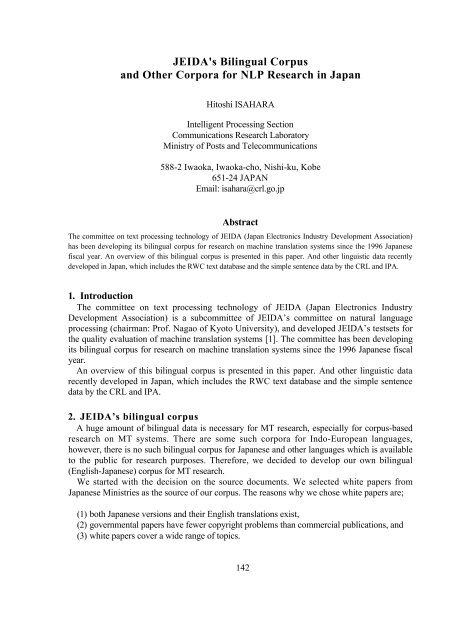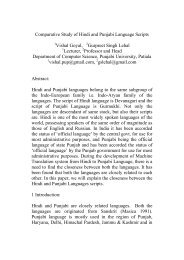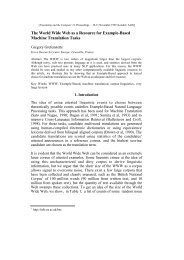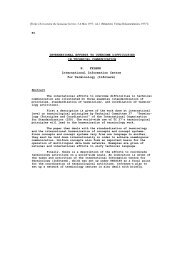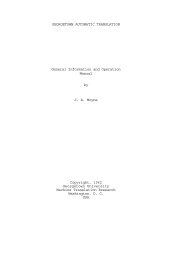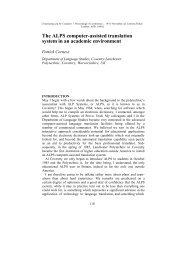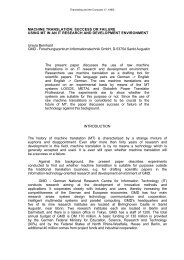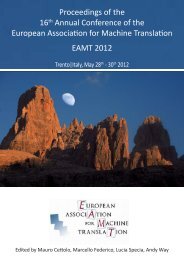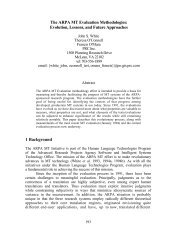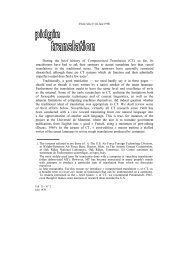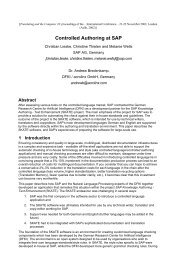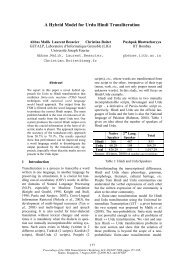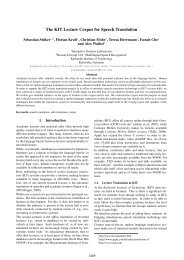JEIDA's bilingual corpus and other corpora for NLP ... - CiteSeerX
JEIDA's bilingual corpus and other corpora for NLP ... - CiteSeerX
JEIDA's bilingual corpus and other corpora for NLP ... - CiteSeerX
You also want an ePaper? Increase the reach of your titles
YUMPU automatically turns print PDFs into web optimized ePapers that Google loves.
<strong>JEIDA's</strong> Bilingual Corpus<br />
<strong>and</strong> Other Corpora <strong>for</strong> <strong>NLP</strong> Research in Japan<br />
Hitoshi ISAHARA<br />
Intelligent Processing Section<br />
Communications Research Laboratory<br />
Ministry of Posts <strong>and</strong> Telecommunications<br />
588-2 Iwaoka, Iwaoka-cho, Nishi-ku, Kobe<br />
651-24 JAPAN<br />
Email: isahara@crl.go.jp<br />
Abstract<br />
The committee on text processing technology of JEIDA (Japan Electronics Industry Development Association)<br />
has been developing its <strong>bilingual</strong> <strong>corpus</strong> <strong>for</strong> research on machine translation systems since the 1996 Japanese<br />
fiscal year. An overview of this <strong>bilingual</strong> <strong>corpus</strong> is presented in this paper. And <strong>other</strong> linguistic data recently<br />
developed in Japan, which includes the RWC text database <strong>and</strong> the simple sentence data by the CRL <strong>and</strong> IPA.<br />
1. Introduction<br />
The committee on text processing technology of JEIDA (Japan Electronics Industry<br />
Development Association) is a subcommittee of JEIDA’s committee on natural language<br />
processing (chairman: Prof. Nagao of Kyoto University), <strong>and</strong> developed JEIDA’s testsets <strong>for</strong><br />
the quality evaluation of machine translation systems [1]. The committee has been developing<br />
its <strong>bilingual</strong> <strong>corpus</strong> <strong>for</strong> research on machine translation systems since the 1996 Japanese fiscal<br />
year.<br />
An overview of this <strong>bilingual</strong> <strong>corpus</strong> is presented in this paper. And <strong>other</strong> linguistic data<br />
recently developed in Japan, which includes the RWC text database <strong>and</strong> the simple sentence<br />
data by the CRL <strong>and</strong> IPA.<br />
2. JEIDA’s <strong>bilingual</strong> <strong>corpus</strong><br />
A huge amount of <strong>bilingual</strong> data is necessary <strong>for</strong> MT research, especially <strong>for</strong> <strong>corpus</strong>-based<br />
research on MT systems. There are some such <strong>corpora</strong> <strong>for</strong> Indo-European languages,<br />
however, there is no such <strong>bilingual</strong> <strong>corpus</strong> <strong>for</strong> Japanese <strong>and</strong> <strong>other</strong> languages which is available<br />
to the public <strong>for</strong> research purposes. There<strong>for</strong>e, we decided to develop our own <strong>bilingual</strong><br />
(English-Japanese) <strong>corpus</strong> <strong>for</strong> MT research.<br />
We started with the decision on the source documents. We selected white papers from<br />
Japanese Ministries as the source of our <strong>corpus</strong>. The reasons why we chose white papers are;<br />
(1) both Japanese versions <strong>and</strong> their English translations exist,<br />
(2) governmental papers have fewer copyright problems than commercial publications, <strong>and</strong><br />
(3) white papers cover a wide range of topics.<br />
142
Because of (1), English sentences in these white papers would not be considered “good”<br />
translations of the meaning in context but are merely sentence-to-sentence or paragraph-to-<br />
paragraph translations. However <strong>and</strong> there<strong>for</strong>e, they suit the current state of <strong>NLP</strong> research.<br />
Our plan to do research on this <strong>bilingual</strong> <strong>corpus</strong> includes research on alignment of parallel texts<br />
<strong>and</strong> acquisition of linguistic in<strong>for</strong>mation from parallel texts.<br />
We have already gotten permission to use white papers from three Japanese ministries: the<br />
Environment Agency, Economic Planning Agency <strong>and</strong> Science <strong>and</strong> Technology Agency. We<br />
are using white papers from the 1992 to 1996 fiscal years. Some of them are available on CD-<br />
ROMs or floppy disks <strong>and</strong> <strong>other</strong>s are available only in a printed <strong>for</strong>m, which we had to input<br />
manually or by using an OCR.<br />
We are <strong>for</strong>matting our <strong>corpus</strong> in TEI <strong>for</strong>mat using the following steps;<br />
(1) Definition of document type.<br />
We define the document type of our <strong>bilingual</strong> <strong>corpus</strong> based on the TEI Lite regulation <strong>and</strong> its<br />
extensions. As <strong>for</strong> chemical <strong>for</strong>mulas, we adopted STANDCOM.DTD in ISO/IEC TR 9573-<br />
11. (See [2], [3], <strong>and</strong> [4] <strong>for</strong> these regulations.)<br />
(2) Conversion of nonst<strong>and</strong>ard characters.<br />
Gaiji (nonst<strong>and</strong>ard characters) in Japanese, are converted into some combinations of st<strong>and</strong>ard<br />
characters. For example, " 1 (1 in a circle)" is converted into "&c-l;".<br />
(3) Regularization of titles <strong>and</strong> bodies.<br />
Be<strong>for</strong>e tagging <strong>bilingual</strong> texts, we have to regularize the texts so that we can identify their<br />
titles <strong>and</strong> bodies automatically. We did this regularization process manually because the titles in<br />
the English versions tend to be very different from the titles in the Japanese versions.<br />
(4) Tagging.<br />
After the regularization, most parts of the tagging, e.g., (a) identification of hierarchy of<br />
sentences, (b) identification of titles, (c) identification of paragraphs, <strong>and</strong> (d) identification of<br />
sentences, can be done automatically. We are using only part of the tags defined by TEI Lite,<br />
e.g., tei, teiHeader, text, body, div, head, p, s, <strong>and</strong> q. However, tasks which we have to do<br />
manually, e.g., assigning alignment attributes <strong>and</strong> identification of quotation, still remain.<br />
As <strong>for</strong> the character code, this <strong>bilingual</strong> <strong>corpus</strong> utilizes JIS (Japanese industrial st<strong>and</strong>ard) X<br />
201 <strong>and</strong> JIS X 0208 <strong>for</strong> Japanese text <strong>and</strong> JIS X 201 <strong>for</strong> English text. They can be easily<br />
converted into EUC code. As <strong>for</strong> Entity Sets, we utilize public entity sets such as ISOlatl,<br />
ISOgrk3, ISOpub, ISOnum, <strong>and</strong> ISOamsr. And also, we defined our own entity set, e.g.,<br />
&<br />
<<br />
><br />
In this fiscal year, we are aligning Japanese sentences with English sentences using an<br />
alignment tool developed by NTT. And, we will also try to add more precise tags to our<br />
<strong>bilingual</strong> <strong>corpus</strong>, such as word alignment tags, part-of-speech tags, <strong>and</strong> syntactic <strong>and</strong> semantic<br />
tags. Figure 1 shows an example of our <strong>corpus</strong> (from a “White Paper on the Environment”).<br />
143
Fig. 1 An Example from the <strong>bilingual</strong> <strong>corpus</strong><br />
144
Problems we faced during our <strong>corpus</strong> development include the following;<br />
(1) Identifying Quotations<br />
(a) Quoted isolated sentences<br />
(b) Quotations embedded in sentences<br />
(c) Remarks embedded in sentences<br />
(2) Identifying itemized sentences<br />
(a) Ordinary itemized sentences<br />
(b) Itemized sentences embedded in an<strong>other</strong> sentence<br />
(c) New lines within itemized sentences<br />
(3) Representation of chemical <strong>for</strong>mulas<br />
(a) Chemical terms which can not be represented by ordinary fonts<br />
(b) Chemical terms which can be represented by ordinary fonts only<br />
These problems are still unsolved, there<strong>for</strong>e, we have to process them manually.<br />
3. RWC text data<br />
The Real World Computing (RWC) Program is a research program funded by the Japanese<br />
Ministry of International Trade <strong>and</strong> Industry (Mm) <strong>and</strong> it established the RWC Database<br />
Working Group in 1994 to gather <strong>and</strong> utilize real world knowledge. The Working Group is<br />
building several databases: text, speech, image <strong>and</strong> so on. Since 1994, the text group of the<br />
RWC Database Working Group has been building an annotated text database of modern<br />
Japanese <strong>for</strong> the research <strong>and</strong> evaluation of <strong>NLP</strong> technology [5].<br />
The RWC text database should:<br />
(1) be very large scale,<br />
(2) include accurately annotated <strong>corpora</strong>, <strong>and</strong><br />
(3) be balanced <strong>and</strong> gathered from actual texts.<br />
The following are the RWC text databases currently available.<br />
(l)RWC-DB-TEXT-94-l<br />
Morphologically analyzed data of MITI reports (manually post-edited; including MITI white<br />
papers <strong>for</strong> 1993-1995)<br />
(2) RWC-DB-TEXT-94-2<br />
Morphologically analyzed data of JEIDA’s annual report. (Manually post-edited. A survey<br />
report on the trend of natural language processing.)<br />
(3)RWC-DB-TEXT-95-l<br />
Differential data of the results of morphological analysis of the CD-Mainichi Shimbun<br />
(newspaper) (covers articles from the Mainichi Shimbun from 1991 to 1994).<br />
This very large tagged <strong>corpus</strong> is the result of automatic morphological analysis of all<br />
sentences in CD-Mainichi Shimbun from 1991 to 1994. This 4-year database comprises about<br />
100 million words (or morphemes).<br />
Since RWC-DB-TEXT-95-1 is very large, it was only processed mechanically. There<strong>for</strong>e it<br />
may include errors, although they are insignificant <strong>for</strong> practical use. We manually post-edited<br />
145
parts of RWC-DB-TEXT-95-1 to make RWC-DB-TEXT-95-2. This database will give basic<br />
data <strong>for</strong> estimating the accuracy of automatic tagging. Furthermore, RWC-DB-TEXT-95-2 can<br />
be used as training data <strong>for</strong> a morphological analyzer to make the remaining data in RWC-DB-<br />
TEXT-95-1 more accurate.<br />
(4) RWC-DB-TEXT-95-2<br />
Results of the morphological analysis of the CD-Mainichi Shimbun (Manually post-edited,<br />
3,000 articles from 1994). This is the result of post-editing all sentences in the 3,000 articles<br />
extracted from RWC-DB-TEXT-95-1. These articles, the length of which ranged from 400 to<br />
600 characters, were r<strong>and</strong>omly selected.<br />
(5) RWC-DB-TEXT-95-3<br />
Articles tagged with the universal decimal classification (UDC). (30,000 articles from 1994.)<br />
This data is very useful <strong>for</strong> research on in<strong>for</strong>mation retrieval.<br />
We’ll make following data available to the public.<br />
(6) Iwanami Kokugo Jiten Data<br />
Morphologically analyzed data from the Iwanami Shoten Japanese dictionary. (Manually<br />
post-edited)<br />
Most of these data are tagged <strong>for</strong> Parts-of-Speech. As <strong>for</strong> syntactic tags, simple sentence<br />
data were extracted by the CRL from RWC-DB-TEXT-95-2 (described in the next section).<br />
Semantic tags will be added to Mainichi Shimbun data using Iwanami Kokugo Jiten.<br />
4. Simple sentence data by the CRL <strong>and</strong> the IPA [6]<br />
The Communications Research Laboratory (CRL) of the Japanese Ministry of Posts <strong>and</strong><br />
Telecommunications extracted modifying relations between nouns <strong>and</strong> verbs (<strong>and</strong> adjectives)<br />
from real sentences in RWC-DB-TEXT-95-2 <strong>and</strong> made a simple sentence database from the<br />
extracted in<strong>for</strong>mation. This data includes 59,939 simple sentences (with 3,243 different verbs)<br />
from 43,430 original sentences from newspaper articles. The In<strong>for</strong>mation Promotion Agency<br />
(IPA) also made the same type of database from its IPA <strong>corpus</strong>. This datum includes 108,262<br />
simple sentences (with 5,161 different verbs) from 57,456 original sentences. Figure 2 shows<br />
an example of original sentences <strong>and</strong> two types of extracted simple sentences.<br />
These simple sentence databases were developed focusing on changes of relations between<br />
particles in the original sentences <strong>and</strong> particles in the extracted simple sentences <strong>and</strong> describe the<br />
modifying relations between nouns <strong>and</strong> verbs. These are very useful (1) in surveying <strong>and</strong><br />
making rules <strong>for</strong> actual linguistic phenomena, <strong>and</strong> (2) as training <strong>and</strong>/or reference data <strong>for</strong> <strong>NLP</strong><br />
applications. CRL is doing research on improving an existing Japanese parser by using the<br />
frequency of patterns of modification which were extracted from the data <strong>and</strong> placed in a<br />
lexicon.<br />
5. Conclusion<br />
Several <strong>corpus</strong> projects, mainly JEIDA’s <strong>bilingual</strong> <strong>corpus</strong> project, are explained in this paper.<br />
These <strong>corpora</strong> are being developed on the principles of being:<br />
146
(1) Available without charge to the public <strong>for</strong> research <strong>and</strong> evaluation of <strong>NLP</strong> technology,<br />
(2) built under cooperation <strong>and</strong> dispersion, <strong>and</strong><br />
(3) general <strong>and</strong> independent of any one specific linguistic theory.<br />
We will continue our ef<strong>for</strong>ts to develop public <strong>corpora</strong> <strong>for</strong> <strong>NLP</strong> research on these principles.<br />
References<br />
[1] Hitoshi Isahara: JEIDA’s Test-Sets <strong>for</strong> Quality Evaluation of MT Systems -- Technical<br />
Evaluation from the Developer's Point of View --, MT Summit V, 1995.<br />
[2] Lou Burnard: TEI Lite: An Introduction to Text Encoding <strong>for</strong> Interchange, C. M. Sperberg-<br />
McQueen, 1995.<br />
[3] Patrice Bonhomme et al.: LINGUA In<strong>for</strong>mation & Technical Aspect, Lingua Project, 1995.<br />
[4] Eve Maler <strong>and</strong> Jeanne El Andaloussi : Developing SGML DTDs From Text to Model to<br />
Markup, Prentice Hall PTR, 1996.<br />
[5] Hitoshi Isahara et al.: Building a text database with POS tags by RWCP (in Japanese), 1st<br />
Annual Meeting of Japanese Society of Natural Language Processing, 1995.<br />
[6] Minako Hashimoto et al.: Extraction of simple sentence data from <strong>corpora</strong> (in Japanese),<br />
3rd Annual Meeting of Japanese Society of Natural Language Processing, 1997.<br />
Fig. 2 An Example of the Simple Sentence Data<br />
147


